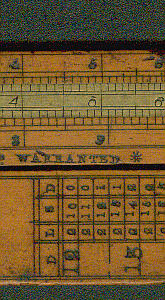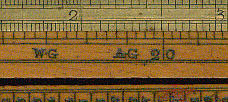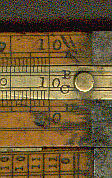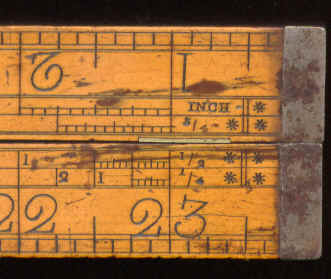1. This is an example of a type of rule sold from the late 17th century until the end of the 19th century. It enabled carpenters to make measurements of timber and calculate areas and volumes. Coggeshall's pamphlet entitled Timber Measure by a Line of more Ease, Dispatch and Exactness than any other way now in use, by a Double Scale. . . ., was published in London, 1677. Cajori (The History of the Logarithmic Slide Rule) has a drawing of a Coggeshall rule from 1723. It shows a similar arrangement of scales except that the numbers increase from right to left, the opposite of the rule shown here.
2. The D scale has one cycle of logarithms and runs from 4 to 40. This is called the "girt line"; the girt being a quarter of the circumference of circular timber. The A, B and C scales have two cycles of logarithms and run from 1 to 100.
3. Even though the scale of squares is displaced, the scales are labelled A, B, C and D which became the standard on later rules.
4. The Cox rule has two gauge points, AG (ale gauge - 18.95) and WG (wine gauge - 17.15) which became obsolete after the introduction of the Imperial measurement system on 1824. The later rules have a gauge point, sometimes marked IG for imperial gallons, at 18.8.
5. The rule has scale with one column of pence and one column of pounds, shillings and pence. The basic currency in the United Kingdom is the pound sterling. Before1971 the pound was divided in 20 shillings, each of which had 12 pence. Amounts were generally written as £2 7s 6d, the £sd being derived from the Latin libra, solidus and denarius. Amounts less than a pound were often written 7/6, for seven shillings and sixpence or -/3½ for amounts less than a shilling. The columns represent the value in pence in the left column multiplied by 50. For example 12½ d. is adjacent to £2 12s. 1d.: 12½ d. times 50 d. is 625 d. : 625 d. is equal to 52 s. and 1d.: 52s 1d. is equal to £2 12s. 1d. The reason for the use of 50 is that 50 cubic feet of timber was classed as a "load". Depending on the type of wood this would weight around 1 ton.
6. On the other face the rule has scales of inches and binary fractions (½, ¼ etc) also of ¾, ½ and ¼ inches.
7. On the edge there is a scale of decimals of a foot. This facilitates the use of the rule for fractions of a foot.
8. To use the rule for measuring the volume of a felled tree it is necessary to get the length in feet and the "girt" in inches. The girt is obtained by passing a cord round the timber and folding it twice (i.e. first into half and then quarter length). Place the length in feet on the C scale against 12 on the D (girt) scale. Against the girt in inches on the D scale you have the volume in cubic feet on the C scale. If you try this yourself (using the D scale on a modern slide rule as the girt line and the B scale on the modern rule in place of the C scale) and compare the results with those using a calculator you will find that the figures don't agree. The value using this method is about 20% less than you expect. (in fact the ratio is p/4). This was to allow for wastage in cutting a tree into rectangular planks. In Thom's book on Mensuration of 1861 the author says "This rule, however, is invariably practised by timber merchants, and is not likely to be abolished." Given that this rule had also applied when Coggeshall introduced his sliding rule around 200 years earlier that certainly seemed to be the case.
9. To find the content of a barrel get the mean diameter as equal to the head diameter (i.e. at the end) plus 70% of the difference between the bung diameter (at the widest point) and the head diameter. Set the length of the barrel on the C scale against the appropriate gauge point (for wine or beer) on the D scale. Against the mean diameter on the D scale read the content in gallons on the C scale. All dimensions in inches.
10. The rule by T Aston dates from a similar data to that of the Cox rule, i.e. around 1820. It has the words "T Aston Maker Warranted Box".
11. The rule by Higgison is later than the other two as it does not have imperial gauge marks. P. Hopp dates Higgison to the late 1800s.
Front view

Maker's name
![]()
Monetary scale

Pre-1824 gauge points

Naming of scales

Fractional measuring scales

Decimal measuring scales

Rule by T. Aston

Rule by Higgison

Aston, c 1820
Higgison, c 1880?